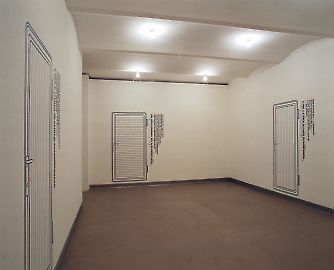Thomas Locher --
Markus Huemer: In one of your catalogues, Wer sagt was und warum, (1) Peter Weibel writes that your work is a critique of reason through reason itself […] Furniture and language are inherently determined by reason, by ratio. It is only the relation of the two elements in your work that does not seem rational. It is this substitution so to speak that removes object and subject from their formal and syntactical identity. But not, as had been the case for conceptual art in the 1960s, in that the principle of denotation was dominant, but in that text and object stand connotatively in relation to one another.
Thomas Locher: Sure, it’s true that my work finds its historical reference point in the classical Concept Art of the 1960s. But at the same time, it represents a critique of Concept Art: Concept Art was influenced by the rationalism of Anglo-American philosophy, which assumes that it is possible to create clear relations between the signifier and the signified. This is why for the objects I use a text that stands in no direct relation to the thing itself. The text doesn’t have to have the character of definition. If you’re trying to critique the concept of identity, then the text you use can’t be committed to this principle of identity. And on top of that, I didn’t just want to carry out an object discourse, but with the help of an object express a subject-subject relationship.
M.H.: This is thus the same artistic principle of function as in your earlier Nummernarbeiten, or Number Works. The numbers, from a mathematical-logical system of reference, have no direct relationship to the color fields in red, yellow, blue, etc. But they still give cause to suspect that they are based on a numerical combinatorics. But by matching a single number to a color field, it becomes clear that the two operate in a kind of “metonymy,” or in texts one would call them “notes” or “footnotes.”
T.L.: As a formal means, I always retained the note or branch, that is, the possibility of formally making a reference. Whether in the concrete case there really is a reference is another matter. The important thing is that for me the note is a formal means to break up the principle of identity, to dissolve one concept into several concepts, for example. In the <k>Nummernarbeiten<k> at issue are numbers and color fields, that is, fully defined, clear elements, as you say, “logical” elements. But in their combination there is a critique of this clarity, because their unambiguous ordering in relation to one another is suspended. Moreover, this results in yet another picture: it was supposed to be a clever picture, but one that could still be enjoyed.
(1) Wer sagt Was und Warum – Vier imaginäre Räume, Kölnischer Kunstverein, Cologne 1992
Markus Huemer, "Dass die Basis der Grundrechte auf Gewalt aufbaut, ist ein Skandal – Ein Gespräch mit Thomas Locher", in: Kunst-Bulletin, December 1995, pp. 8-11.




